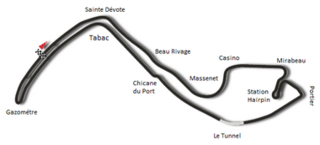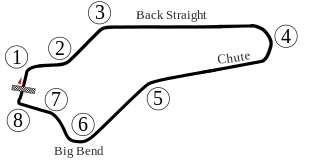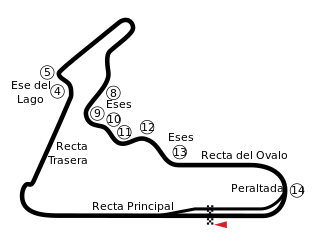
John Surtees, was a British Grand Prix motorcycle road racer and Formula One driver. He was a four-time 500 cc motorcycle World Champion – winning that title in 1956, 1958, 1959 and 1960 – the Formula One World Champion in 1964, and remains the only person to have won World Championships on both two and four wheels. He founded the Surtees Racing Organisation team that competed as a constructor in Formula One, Formula 2 and Formula 5000 from 1970 to 1978. He was also the ambassador of the Racing Steps Foundation.

The Cooper Car Company is a British car manufacturer founded in December 1947 by Charles Cooper and his son John Cooper. Together with John's boyhood friend, Eric Brandon, they began by building racing cars in Charles's small garage in Surbiton, Surrey, England, in 1946. Through the 1950s and early 1960s they reached motor racing's highest levels as their rear-engined, single-seat cars competed in both Formula One and the Indianapolis 500, and their Mini Cooper dominated rally racing. The Cooper name lives on in the Cooper versions of the Mini production cars that are built in England, but is now owned and marketed by BMW.

Silverstone Circuit is a motor racing circuit in England, near the Northamptonshire villages of Silverstone and Whittlebury. It is the current home of the British Grand Prix, which it first hosted as the 1948 British Grand Prix. The 1950 British Grand Prix at Silverstone was the first race in the newly created World Championship of Drivers. The race rotated between Silverstone, Aintree and Brands Hatch from 1955 to 1986, but settled permanently at the Silverstone track in 1987. The circuit also hosts the British round of the MotoGP series.

The 1966 Monaco Grand Prix was a Formula One motor race held at the Circuit de Monaco on 22 May 1966. It was race 1 of 9 in both the 1966 World Championship of Drivers and the 1966 International Cup for Formula One Manufacturers. The race was the first World Championship event of a new era for Formula One, for which engine regulations were altered from 1.5 litres of maximum engine displacement to 3.0 litres. The race was the 24th Monaco Grand Prix.

The 1966 Belgian Grand Prix was a Formula One motor race held at Spa-Francorchamps on 12 June 1966. It was race 2 of 9 in both the 1966 World Championship of Drivers and the 1966 International Cup for Formula One Manufacturers. The race was the 26th Belgian Grand Prix and was held over 28 laps of the 14.1-kilometre circuit for a race distance of 395 kilometres.

The 1966 Italian Grand Prix was a Formula One motor race held at Monza on 4 September 1966. It was race 7 of 9 in both the 1966 World Championship of Drivers and the 1966 International Cup for Formula One Manufacturers. The race was the 36th Italian Grand Prix and the 32nd to be held at Monza. The race was held over 68 laps of the five kilometre circuit for a race distance of 391 kilometres.

The 1966 United States Grand Prix was a Formula One motor race held on October 2, 1966, at the Watkins Glen Grand Prix Race Course in Watkins Glen, New York. It was race 8 of 9 in both the 1966 World Championship of Drivers and the 1966 International Cup for Formula One Manufacturers. The race was the ninth United States Grand Prix. It was the sixth to be held at Watkins Glen. The race was held over 108 laps of the 3.78-kilometre circuit for a total race distance of 408 kilometres.

The 1966 Mexican Grand Prix was a Formula One motor race held at the Ciudad Deportiva Magdalena Mixhuca on 23 October 1966. It was race 9 of 9 in both the 1966 World Championship of Drivers and the 1966 International Cup for Formula One Manufacturers. The race was the fifth Mexican Grand Prix and the first to be run under the new three-litre Formula. It was held over 65 laps of the 5 km (3.1 mi) circuit for a race distance of 325 km (202 mi).

The 1967 Monaco Grand Prix was a Formula One motor race held at Monaco on May 7, 1967. It was race 2 of 11 in both the 1967 World Championship of Drivers and the 1967 International Cup for Formula One Manufacturers, albeit four months after Pedro Rodríguez's unexpected victory at Kyalami. The 100-lap race was won by Brabham driver Denny Hulme after he started from fourth position. Graham Hill finished second for the Lotus team and Ferrari driver Chris Amon came in third.

The 1967 German Grand Prix was a motor race for both Formula One and Formula Two cars held at the Nürburgring on 6 August 1967. It was race 7 of 11 in both the 1967 World Championship of Drivers and the 1967 International Cup for Formula One Manufacturers as well as race 3 of 10 of the 1967 European Formula Two Championship. The 15-lap race was won by Brabham driver Denny Hulme after he started from second position. His teammate Jack Brabham finished second and Ferrari driver Chris Amon came in third.
The 1968 Formula One season was the 22nd season of the FIA's Formula One motor racing. It featured the 19th FIA World Championship, which commenced on 1 January 1968, and ended on 3 November after twelve races, and numerous non-championship races.
The 1966 Formula One season was the 20th season of FIA Formula One motor racing. It featured the 1966 World Championship of Drivers and the 1966 International Cup for F1 Manufacturers which were contested concurrently over a nine-race series that commenced on 22 May and ended on 23 October. The season also included a number of non-championship races for Formula One cars.
The 1961 Formula One season was the 15th season of Formula One motor racing. It featured the 1961 World Championship of Drivers and the 1961 International Cup for F1 Manufacturers, which were contested concurrently from 14 May to 8 October over an eight race series. The season also included numerous non-championship races for Formula One cars.
The 1960 Formula One season was the 14th season of the FIA's Formula One motor racing. It featured the eleventh FIA World Championship of Drivers, the third International Cup for F1 Manufacturers and numerous non-championship Formula One races. The World Championship commenced on 7 February 1960 and ended on 20 November after ten races. Jack Brabham won his second consecutive title with his Cooper team defending its constructors' title.

Michael Johnson Parkes was a British racing driver, from England. Parkes was born into an automotive background as his father John, was Chairman of the Alvis Group.
Reginald Parnell was a racing driver and team manager from Derby, England. He participated in seven Formula One World Championship Grands Prix, achieving one podium, and scoring a total of nine championship points.

The Brabham BT19 is a Formula One racing car designed by Ron Tauranac for the British Brabham team. The BT19 competed in the 1966 and 1967 Formula One World Championships and was used by Australian driver Jack Brabham to win his third World Championship in 1966. The BT19, which Brabham referred to as his "Old Nail", was the first car bearing its driver's name to win a World Championship race.

The Cooper T51 was a Formula One and Formula Two racing car designed by Owen Maddock and built by the Cooper Car Company for the 1959 Formula One season. The T51 earned a significant place in motor racing history when Jack Brabham drove the car to become the first driver to win the World Championship of Drivers with an engine mounted behind them, in 1959. The T51 was raced in several configurations by various entrants until 1963 and in all no less than 38 drivers were entered to drive T51s in Grand Prix races.

Ecurie Bonnier, Ecurie Suisse, Joakim Bonnier Racing Team and Anglo-Suisse Racing Team were names used by Swedish racing driver Joakim Bonnier to enter his own cars in Formula One, Formula Two and sports car racing between 1957 and his death in 1972. Commonly the vehicles were entered for Bonnier himself, but he also provided cars for a number of other drivers during the period.
The 1960 Formula Two season was the last season of 1.5 litre Formula Two racing which was to become Formula One for 1961. Two championships were held over the same five events, the Formula Two Constructors' Championship and the Formula Two Drivers' Championship, in addition to many non-championship Formula Two events. The Constructors' Championship was won in a draw by Cooper-Climax and Porsche, while the Drivers' Championship was won by Jack Brabham.













